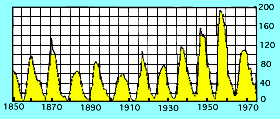The SunThis uneven rotation, coupled with the churning of the upper layers, might well be what produces (by a "dynamo mechanism", described in a later section) regions of intense magnetic field, seen by observers on Earth as dark sunspots. A German amateur astronomer, Heinrich Schwabe, noticed around 1850 that the number of such spots rose and fell in an irregular cycle of about 11 years (see figure below, tracking the "sunspot number" for over a century).
Near the peak of the cycle violent energy releases occur near sunspots, emitting x-rays, radio bursts and rapidly moving plasma clouds, which can produce magnetic storms when they reach Earth. On occasion, especially in large events, the releases also produce high energy ions which spread out through interplanetary space, to the Earth's orbit and beyond. Such events are often associated with "flares," sudden brightenings in the chromosphere, a high layer in the Sun's atmosphere. The chromosphere is best seen through filters which only pass the red light of hydrogen, and it is through such filters that flares are usually seen--though the very first flare observation, by Richard Carrington in 1859, was made through a regular telescope. Click here to read Richard Christopher Carrington's account of observing a flare on September 1, 1859.
The Sun's CoronaSince the Sun's heat comes from its deep core, one would expect the temperature of its layers to drop with increasing distance from the central furnace. In fact, this does not happen. While the visible face of the Sun (the photosphere layer) has a temperature around 6000 deg. C, the corona which begins only a few thousand kilometers higher reaches a million degrees (1.8 million deg. F). No satisfactory explanation has ever been given--somehow, apparently, energy is transmitted to the outer layers of the Sun in ways that go beyond the ordinary flow of heat.
The Solar WindAs the solar wind leaves the corona, it picks up the local magnetic field--contributed by sunspots and by the Sun's magnetic poles--and drags its field lines into space, forming the interplanetary magnetic field (IMF). The IMF is quite weak--at the Earth's orbit, only 1/10,000 of the field at the Earth's surface--but as shown in a later section, it exerts an extraordinary influence on the Earth's magnetosphere. As already noted, field lines in a plasma act like wires on which ions and electrons are strung. If the field is strong, these particles are forced to go to wherever the lines guide them. On the other hand, when the particles are numerous and energetic, as is the case with the solar wind, they can push the magnetic field around. When their flow is deflected, for instance, the lines will change shape, so as to always thread the same particles. Because of this effect, the structure of the IMF even at the greatest distances tends to "remember" the Sun's rotation at its region of origin.
|
 Sunspot Cycle (1850 - 1975)
Sunspot Cycle (1850 - 1975) More about the Sun
More about the Sun More about the Sun's corona
More about the Sun's corona More about the solar wind
More about the solar wind